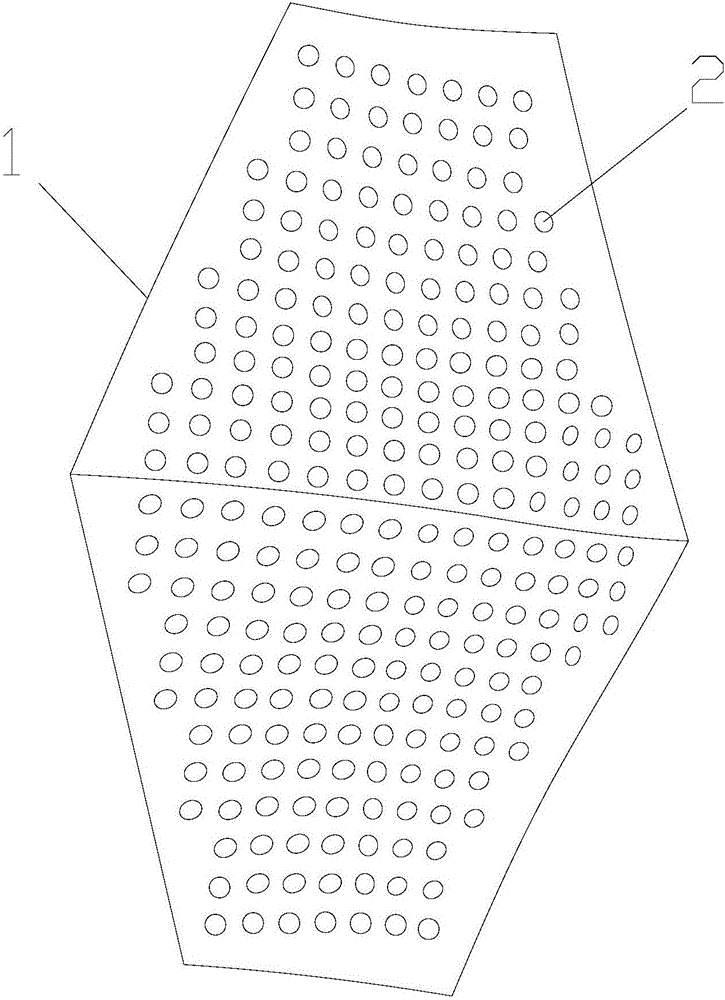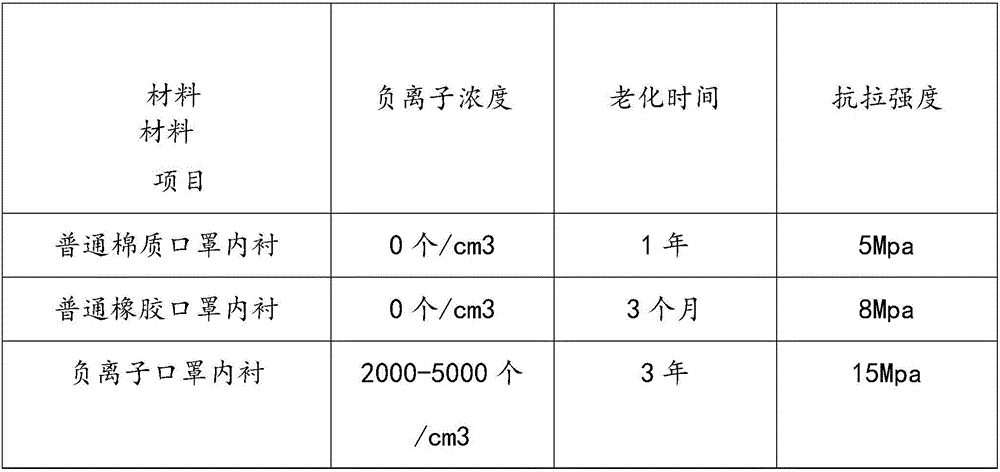Negative ion mask inner liner and preparation method thereof
A technology of negative ions and masks, applied in the field of masks, can solve the problems that the inner lining of masks cannot generate negative ions, cannot improve immunity, and the tensile strength of materials is not high, so as to improve immunity, enhance disease resistance, and improve lungs. Effect of ventilation function
- Summary
- Abstract
- Description
- Claims
- Application Information
AI Technical Summary
Problems solved by technology
Method used
Image
Examples
Embodiment 1
[0024] A kind of negative ion mouth mask liner comprises body 1, and described body 1 is hexagonal, and described body 1 surface is evenly distributed with through hole 2, and described through hole 2 is circularly arranged, and described body 1 is made of following parts by weight It is made of several proportioned materials: 22 parts of coral fossils, 48 parts of tourmaline, 25 parts of lanthanum oxalate, 13 parts of dysprosium carbonate, 8 parts of latex, 3 parts of polyethylene terephthalate, 9 parts of polycarbonate, 13 parts of polymethacrylate, 6 parts of epoxy soybean oil, 7 parts of calcium carbonate, 3 parts of magnesium carbonate, 12 parts of stilbene, 17 parts of diisobutyl phthalate, 8 parts of diethyl phthalate 21 parts of p-phenylenediamine, 10 parts of polylactic acid and 8 parts of polyglycolide.
[0025] A preparation method for anion mask lining, comprising the following steps:
[0026] 1) 22 parts of coral fossils, 48 parts of tourmaline, 25 parts of l...
Embodiment 2
[0035] A kind of negative ion mouth mask liner comprises body 1, and described body 1 is hexagonal, and described body 1 surface is evenly distributed with through hole 2, and described through hole 2 is circularly arranged, and described body 1 is made of following parts by weight It is made of several proportioned materials: 23.5 parts of coral fossils, 49 parts of tourmaline, 27.5 parts of lanthanum oxalate, 14 parts of dysprosium carbonate, 10 parts of latex, 5.5 parts of polyethylene terephthalate, 12 parts of polycarbonate, 15.5 parts of polymethacrylate, 7 parts of epoxy soybean oil, 10.5 parts of calcium carbonate, 5.5 parts of magnesium carbonate, 14 parts of stilbene, 18.5 parts of diisobutyl phthalate, 9 parts of diethyl phthalate 23.5 parts of p-phenylenediamine, 12.5 parts of polylactic acid and 11 parts of polyglycolide.
[0036] A preparation method for anion mask lining, comprising the following steps:
[0037] 1) 23.5 parts of coral fossils, 49 parts of tourm...
Embodiment 3
[0046] A kind of negative ion mouth mask liner comprises body 1, and described body 1 is hexagonal, and described body 1 surface is evenly distributed with through hole 2, and described through hole 2 is circularly arranged, and described body 1 is made of following parts by weight It is made of several proportioned materials: 25 parts of coral fossils, 50 parts of tourmaline, 30 parts of lanthanum oxalate, 15 parts of dysprosium carbonate, 12 parts of latex, 8 parts of polyethylene terephthalate, 15 parts of polycarbonate, 18 parts of polymethacrylate, 8 parts of epoxy soybean oil, 14 parts of calcium carbonate, 8 parts of magnesium carbonate, 16 parts of stilbene, 20 parts of diisobutyl phthalate, 10 parts of diethyl phthalate 26 parts of p-phenylenediamine, 15 parts of polylactic acid and 14 parts of polyglycolide.
[0047] A preparation method for anion mask lining, comprising the following steps:
[0048] 1) Mix 25 parts of coral fossils, 50 parts of tourmaline, 30 parts...
PUM
 Login to View More
Login to View More Abstract
Description
Claims
Application Information
 Login to View More
Login to View More - R&D
- Intellectual Property
- Life Sciences
- Materials
- Tech Scout
- Unparalleled Data Quality
- Higher Quality Content
- 60% Fewer Hallucinations
Browse by: Latest US Patents, China's latest patents, Technical Efficacy Thesaurus, Application Domain, Technology Topic, Popular Technical Reports.
© 2025 PatSnap. All rights reserved.Legal|Privacy policy|Modern Slavery Act Transparency Statement|Sitemap|About US| Contact US: help@patsnap.com


